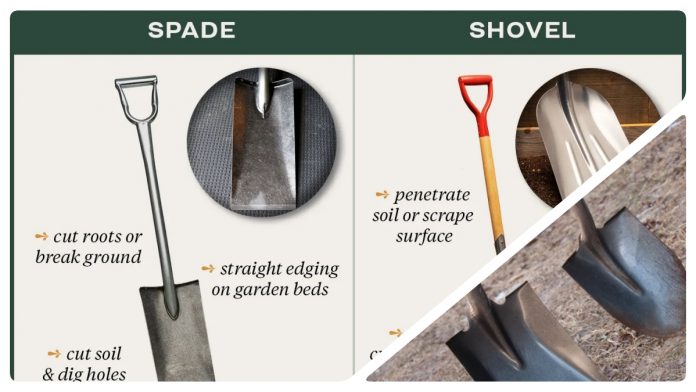When it comes to working in the garden or tackling outdoor projects, having the right tools can make a significant difference in the efficiency and success of your endeavors. Among the essential tools for digging and moving soil, two commonly used tools are the shovel and the spade. While these tools may appear similar at first glance, they have distinct differences in design and purpose. In this article, we will explore the disparities between a shovel and a spade, helping you understand when and how to use each tool effectively.
- Design and Construction: The shovel and spade differ in their overall design and construction, making them suitable for specific tasks.
- Shovel: A shovel typically has a curved blade with a concave shape. It is designed to scoop and move loose materials such as soil, sand, gravel, or snow. Shovels often have a long handle attached to the blade, providing leverage and making it easier to lift and transport heavy loads.
- Spade: A spade, on the other hand, features a flat, rectangular blade with straight edges. The blade of a spade is typically sharper and more rigid than that of a shovel. Spades often have a shorter handle, offering better control and precision when working in confined spaces or when performing tasks that require more accuracy.
- Purpose and Applications: The shovel and spade are intended for different applications based on their design and capabilities.
- Shovel: Shovels are commonly used for tasks that involve digging and moving loose materials. They excel in jobs like digging holes for planting trees or shrubs, creating trenches for irrigation or drainage, and transferring bulk amounts of soil, gravel, or compost. The curved shape of the shovel’s blade allows it to hold more material and move it efficiently.
- Spade: Spades are well-suited for tasks that require more precise digging and cutting. They are ideal for activities such as edging garden beds, removing sod or turf, digging trenches for laying cables or pipes, and transplanting small plants. The flat, sharp-edged blade of a spade makes it easier to cut through roots or dense soil and provides greater control when working in tight spaces.
- Soil and Ground Conditions: Considering the type of soil and ground conditions is crucial when selecting between a shovel and a spade.
- Shovel: Shovels are more effective in loose or semi-compact soil, where their scooping action can quickly collect and move large volumes of material. They are particularly useful when dealing with sandy or loamy soil that is easily displaced.
- Spade: Spades perform better in compact or heavy soils that require more cutting or slicing action. The sharp edge of the spade can penetrate hard-packed soil or clay more efficiently, making it easier to dig holes or remove stubborn roots. Spades are also preferred when working in established garden beds or when precision is required.
- Ergonomics and Comfort: Both the shovel and spade vary in their ergonomics and the physical effort required to use them.
- Shovel: The long handle of a shovel allows for greater leverage, reducing strain on the back and muscles when lifting heavy loads. This design is advantageous when moving large amounts of material over longer distances. However, the extended handle might be less suitable for working in tight spaces or when you need more control.
- Spade: The shorter handle of a spade provides better maneuverability and control, making it easier to work in confined areas or when performing tasks that demand precise movements. The compact design of a spade can help minimize strain on the arms and back when working for extended periods. However, the reduced leverage may require more effort for lifting heavy loads.
In conclusion, while the shovel and spade are both indispensable tools for gardeners and outdoor enthusiasts, understanding their differences is essential for choosing the right tool for the job. Shovels are designed for moving loose materials efficiently, making them suitable for tasks like digging and transferring soil. Spades, on the other hand, excel in precise digging, cutting, and working in compact or established areas. By considering the type of task, soil conditions, and desired level of control, you can select the appropriate tool to maximize productivity and achieve better results in your gardening and landscaping projects.


